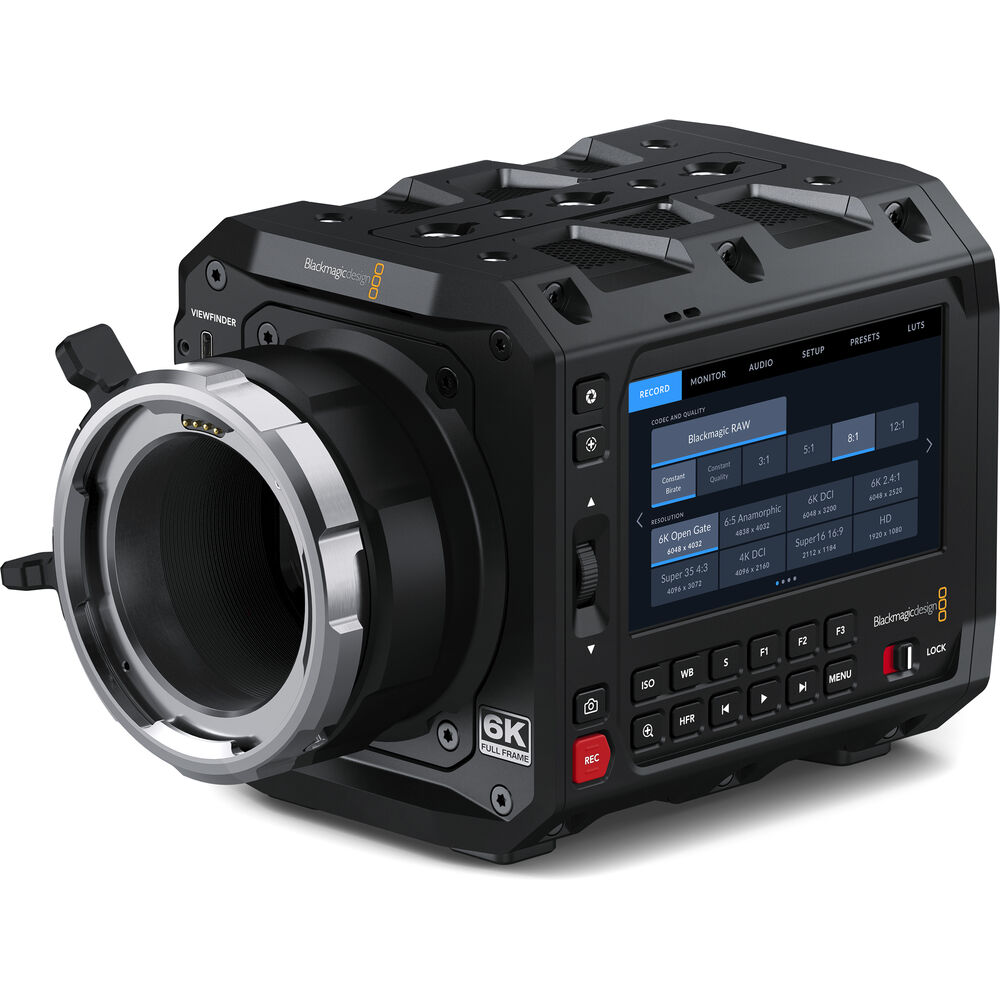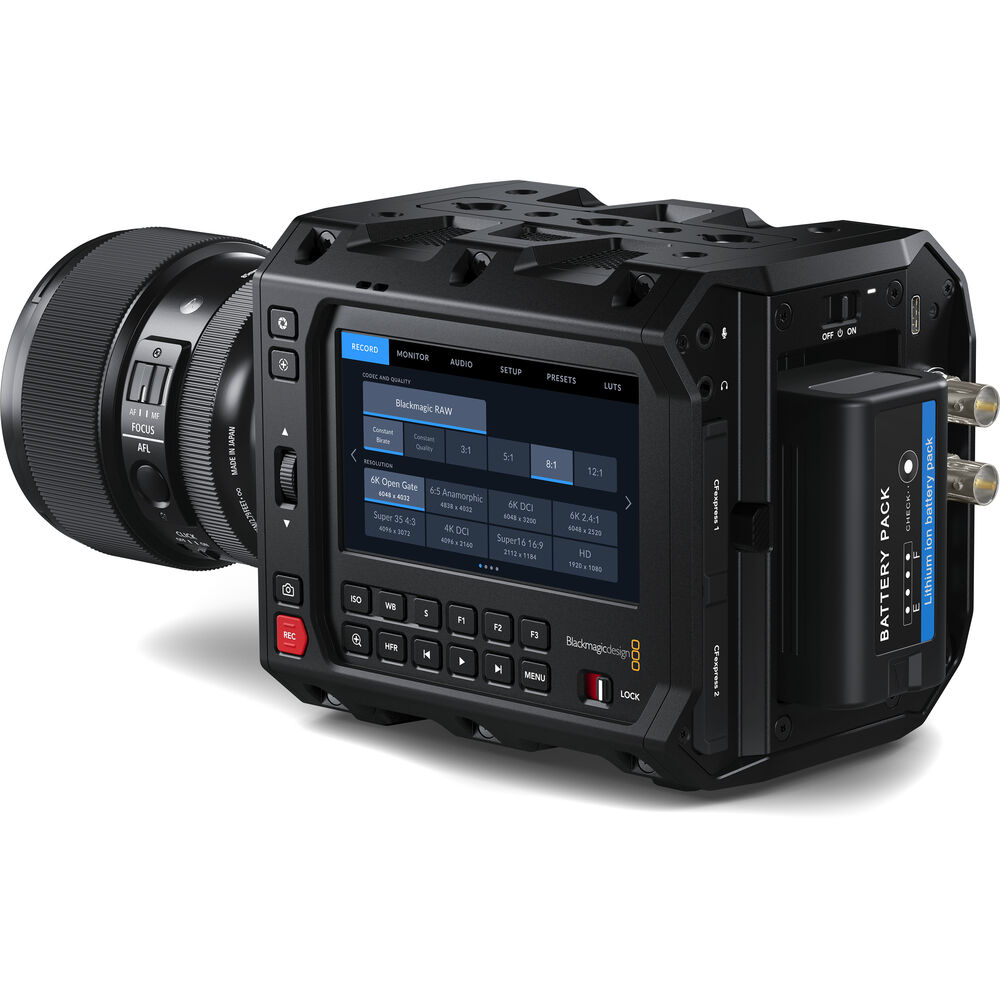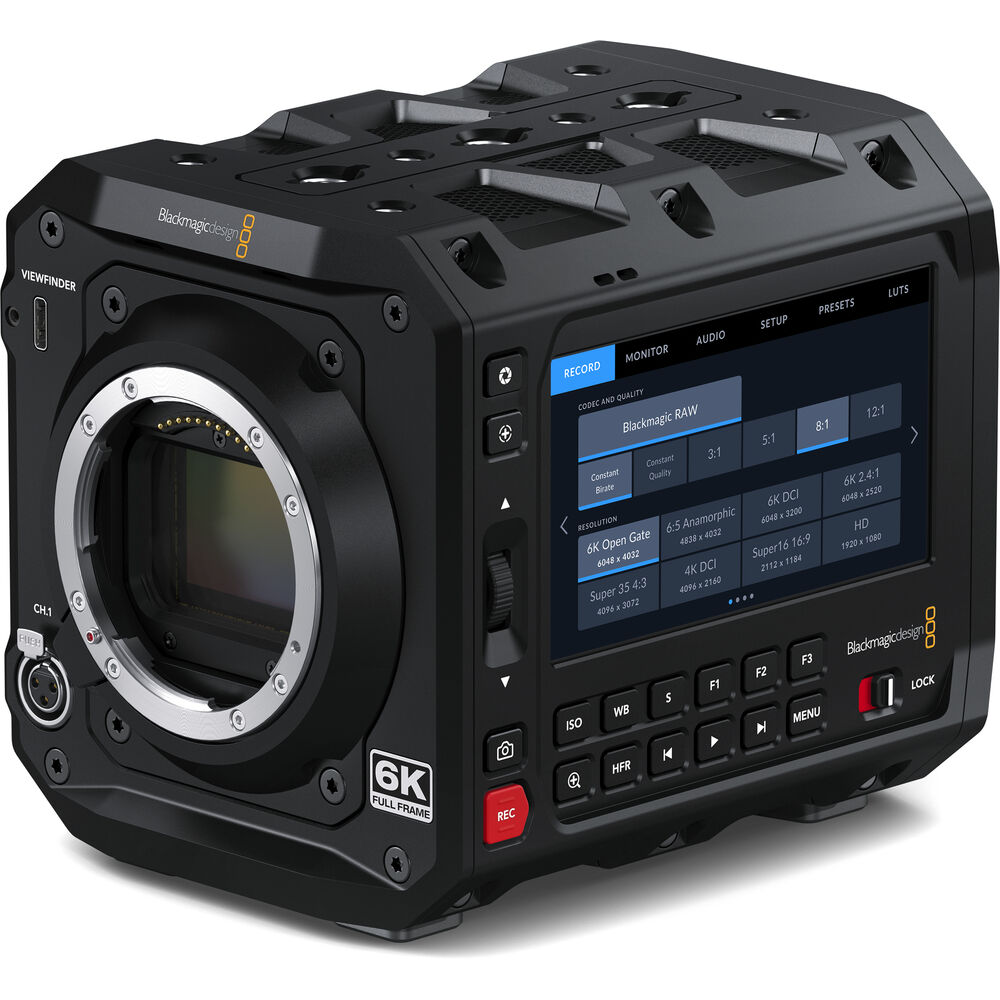Blackmagic Design has overhauled the design of their not-so-pocket Cinema Camera 6K (Amazon, B&H) into a box form factor, called the Blackmagic Design PYXIS 6K (Amazon, B&H).
The price point is similar enough for anyone to wonder what the difference is, and which camera offers the best value for money in 2024. Let’s find out!
Which camera offers a better Resolution and Frame Rates
Both the PYXIS 6K and the Cinema Camera 6K are full frame cameras with a sensor size of 36x24mm.
Here’s what you get with both cameras in terms of resolution and frame rates:
| Camera | Best Possible Resolution | Max FPS | Max FPS in 4K DCI |
| PYXIS 6K | 6048 x 4032 | 36 fps | 60 fps |
| Cinema Camera 6K | 6048 x 4032 | 36 fps | 60 fps |
It’s almost as if they are the exact same sensor, and changing to a box form factor did not:
- Improve the cooling in any substantial way to get better frame rates
- Come with better processing for higher frame rates
I have to admit it is disappointing for the PYXIS not to have 4K 120 fps.

Which camera is better in low light?
Both cameras come with dual native ISO:
| Camera | Video ISO Range |
| PYXIS 6K | Dual Native ISO 400 and 3200 |
| Cinema Camera 6K | Dual Native ISO 400 and 3200 |
The entire range is 100-25,600.
Which camera has the better dynamic range?
| Camera | Dynamic Range |
| PYXIS 6K | 13 stops |
| Cinema Camera 6K | 13 stops |
I think by this point we can safely say both cameras have identical sensors for all practical purposes.
What we need to look for then, are features that differentiate them for practical filmmaking.

Which camera has more lens mounts?
The PYXIS gives you more choices:
| Camera | Lens mounts |
| PYXIS 6K | Leica L, Canon EF, Arri PL |
| Cinema Camera 6K | Leica L |
At least the codecs and color features have been improved, right?
Here’s the info:
| Camera | RAW and Codec in 4K | Color Information for 4K |
| PYXIS 6K | 12-bit Blackmagic RAW | RAW |
| Cinema Camera 6K | 12-bit Blackmagic RAW | RAW |
Nope.
Ergonomics
Here I expect to see some major differences, but not with focus and exposure aids. The software is pretty much the same.
The body size and weights are obviously different:
| Camera | Dimensions in mm (Width x Height x Length) | Weight |
| PYXIS 6K | 119 x 106 x 151 | 1.5 kg |
| Cinema Camera 6K | 180 x 122 x 94 | 1.135 kg |
Here’s the thing. If you calculate the volume (space consumed) of both cameras, they are very similar. The Blackmagic Design Cinema Camera 6K (Amazon, B&H) has the edge here because it is lighter in weight.
Why? For one, the Blackmagic Design PYXIS 6K (Amazon, B&H) has a monitor on the side:
| Camera | Screen Size | Screen Resolution | Screen Brightness | Screen Position |
| PYXIS 6K | 4″ | 1920 x 1080 | 1500 nits | Left side |
| Cinema Camera 6K | 5″ | 1920 x 1080 | 1500 nits | On the back |
The Cinema Camera 6K has a larger screen in a better position. Having the screen on the left (one that cannot swivel) is frustrating for solo operators.
And let’s make no mistake, both cameras are primarily going to be used by solo operators, no matter what kind of work they’re filming. I’d go as far as to say the fixed screen on the left is a major disadvantage to the PYXIS 6K.
The size and position of the LCD touchscreen on the Blackmagic Design Cinema Camera 6K (Amazon, B&H) give it a clear practical edge here.
The PYXIS offers more buttons (again on the left, which is not very practical for solo operators), while the Cinema Camera 6K has buttons on the top. It’s as if Blackmagic Design has decided for themselves everyone (or mostly everyone) who buys the PYXIS 6K will also have an assistant on the left operating controls.
Weather sealing is not guaranteed on any of the cameras.
The PYXIS does have an aluminum body with 1/4″ and 3/8″ mounting holes for rigging.

Surely ND filters make up the difference?
No. Neither camera has built-in ND filters.
This is shameful, as the Blackmagic Pocket Cinema Camera Pro 6K (Amazon, B&H) has in built ND Filters with 2,6 and 8 stops. I’ve made a comparison of that camera here:
Does the PYXIS 6K offer better audio features and controls?
Here are the audio ports available on both cameras:
| Camera | Audio In | Audio Out |
| PYXIS 6K | 1 x mini XLR analog 1 x 3.5mm stereo jack | 1 x 3.5mm headphone jack |
| Cinema Camera 6K | 2 x mini XLR analog 1 x 3.5mm stereo jack | 1 x 3.5mm headphone jack |
The Blackmagic Design Cinema Camera 6K (Amazon, B&H) has an additional mini XLR input for two microphone shoots. Moving to a box form factor hasn’t made the PYXIS any desirable in the audio department.
However, it has one additional feature.
Timecode
The Blackmagic Design PYXIS 6K (Amazon, B&H) has Tri-Sync/Black Burst and Timecode. In their own words:
Simply plug in an external timecode generator to the BNC timecode input and the camera will automatically detect timecode and lock the internal generator. Now each camera can start and stop recording and all the shots from all cameras will have the same matched timecode. Imagine shooting a music festival with multiple roving cameras! Best of all, DaVinci Resolve will automatically find and sync the shots from all cameras so you don’t need to waste time sorting through thousands of shots!
Blackmagic Design
I’m not sure it has the same accurate timecode clock as the Pocket 6K Pro. The latter has less than a 1 frame drift every 8 seconds.
My thoughts? Even though this feature is useful, you do need to purchase a timecode generator and follow that workflow. On the flip side, you only have on XLR input, so you’re also looking at an external audio recorder.
I’m not a fan of camera audio, so I’ll give this one to the Blackmagic Design PYXIS 6K (Amazon, B&H).
Image Stabilization
Neither camera has IBIS. This means you’ll need gimbals. Here, the Cinema Camera 6K (Amazon, B&H) has the weight advantage. The box form factor could be useful in theory, but most gimbals can adapt to the “Pocket” form factor already.
Media cards and Data
Here’s a look at the media situation:
| Camera | Card slots | Data Rate in 6K RAW 3:1 |
| PYXIS 6K | 2 x CFexpress Type B card slot, 1 x USB-C 3.1 Gen 1 | 370 MB/s |
| Cinema Camera 6K | 1 x CFexpress Type B card slot, 1 x USB-C 3.1 Gen 1 | 370 MB/s |
I’d prefer dual CFexpress slots for redundancy. The second Type B slot is for relay style continuous recording only. You can only record to one card at a time. When that fills up, the second card can take over.
Battery Life and Power
We won’t have exact information on battery life unless we test the PYXIS, since the manufacturer has always been sketchy with such details.
| Camera | Battery Type | Cost of one battery | External Power |
| PYXIS 6K | BP-U | $149** | 1 x External 12V power supply (11-19.5V) |
| Cinema Camera 6K | NP-F570 | $55* | 1 x External 12V power supply (12V-20V) |
**IDX equivalent battery, approximately
The BP-U batteries can get larger and give greater runtimes, but are more expensive.
The Cinema Camera 6K had an official runtime of 60 minutes per full charge, and I expect the PYXIS to have a similar performance, given most of the features are the same. In fact, it might give a better performance.
I’ll give this round to the Blackmagic Design PYXIS 6K (Amazon, B&H). The caveat is the greater weight addition, but that’s true of any battery.

SDI or HDMI?
| Camera | HDMI | SDI |
| PYXIS 6K | No | 12G-SDI |
| Cinema Camera 6K | Yes | No |
The PYXIS 6K has an SDI port, which is more professional for sure. However, most monitors owned in this price range are HDMI monitors.
I really don’t understand this design, except for two scenarios:
- It’s actually a test camera for a Pro model coming soon. They just wanted to see what people will complain about, so they could fix it.
- It really is designed to compare alongside the Canon C70, Sony FX6 and even the Red Komodo.
I’ll be comparing the PYXIS to these cameras in the next day or two. Let’s see if the camera really can hold its own against these proven winners.
Which camera is cheaper to own?
Let’s just add up the costs:
| Camera | PYXIS 6K | Cinema Camera 6K |
| Camera body | $2,995 | $2,495 |
| Batteries* | $894 | $330 |
| Total | $3,889 | $2,825 |
That’s a $1,000 difference.
So, what do you really get? A recap:
| Feature | Winner |
| Resolution | Tie |
| 4K 120fps | None |
| DR and Color | Tie |
| RAW and Codecs | Tie |
| Internal ND filters | None |
| Low Light Performance | Tie |
| Exposure Aids | Tie |
| Media | PYXIS 6K |
| Lenses | PYXIS 6K |
| Ergonomics | Cinema Camera 6K |
| IBIS | Tie |
| Ports and Monitoring | Cinema Camera 6K |
| Audio | Cinema Camera 6K |
| Autofocus and Manual Focus | Tie |
| Battery life | Tie |
| Overheating | TBD, but should be similar |
Before we take our final decision, we’ll let the cameras tell us what they offer that the other doesn’t:
| Camera | USP | Major Cons |
| PYXIS 6K | Two card slots, Timecode, Lens mounts, 1/4″ and 3/8″ mounting points, Can use URSA EVFs, Built-in Live Streaming | Heavier, more expensive batteries, only one XLR input, poor LCD placement |
| Cinema Camera 6K | Ergonomics, Price, two XLR inputs | Wide body |

Verdict
Are the advantages of the Blackmagic Design PYXIS 6K (Amazon, B&H) worth the price difference?
You can use adapters for lens mounts. The two card slots are not really deal breakers. People have been shooting with single card slots for ages. Timecode is useful, but again, not enough to justify an upgrade. Those who live stream could find it useful, or maybe not with the LCD on the left and only one XLR input.
The downsides do bite, especially the weight and the terrible LCD screen placement on the left.
As long as Blackmagic Design doesn’t discontinue it (they probably might), the Blackmagic Design Cinema Camera 6K (Amazon, B&H) wins.
Save your money and use it for batteries or lenses.
What do you think?



6 replies on “Which is the better value for money: the new Blackmagic Design PYXIS 6K or the Cinema Camera 6K?”
Even the 6K Pro is a better camera! S35, sure, but ND.
Disappointed, for us the P is too little and the new 12K too much.
Love BM, but they need to keep trying
I agree!
You are 100© right about every single point here my friend! 100% correct!!!! Please do as long form video! I’m expecting a pyxis 6k pro soon with internal ND, movable screen and a other of the intentionally left or gap fillers that bm did to this camera.
Thank you! I, too, think this is a stopgap for a future pro version.
According to Blackmagic, the PYXIS battery provides three hours of runtime. The screen on the side is not an issue for me, because most people use external monitors on box shaped cameras. The PYXIS is made of aerospace aluminum. If you have an assistance camera man, he can use the side monitor without getting in the way of the operator. For me, the price itself makes it worth it. My main concern is if we can use the current Blackmagic SDI monitors to control the PYXIS. I’ve emailed Blackmagic about it. Still waiting to hear back. Before I decide on getting the PYXIS or not, I will wait for some users to drop videos on their experience and samples of footage from the PYXIS. I’m not as negative about it as some are. To be honest, I was rather surprised how many people complained about it. The Red Komodo X costs 5x as much, and doesn’t offer much more then the PYXIS does for the price difference.
Hi Todd, the PYXIS battery recommendation is 98 Wh, which gives 3 hours of runtime. At 12V, that’s about 8000mAh. The performance on paper is slightly better than the Cinema Camera 6K, but real world tests are needed.
Can’t beat the price, though!